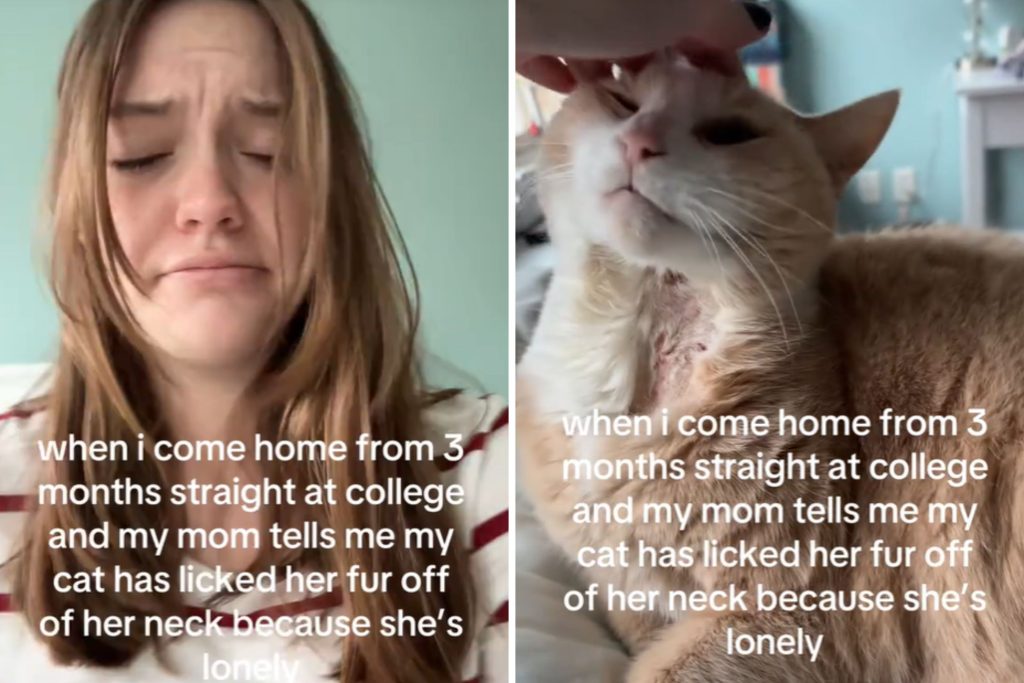The viral TikTok video shared by user @valid8.me depicts a heartbreaking scene: a 17-year-old ginger cat with a raw, furless patch on its neck, a consequence of excessive licking brought on by the stress of her owner’s three-month absence at college. The video, which garnered over 1.5 million views, sparked a wave of sympathy and concern from viewers, highlighting the often-overlooked emotional depth of our feline companions and the impact our absences can have on their well-being. This incident serves as a poignant reminder of the importance of understanding and addressing our pets’ emotional needs, especially during times of change and separation.
The cat’s owner, visibly distraught in the video, explains that this is the first instance of such behavior in the cat’s 17 years. A visit to the veterinarian ruled out allergies as a potential cause, as no changes had been made to the cat’s lifestyle or diet. The vet concluded that the excessive licking, a form of self-soothing, stemmed from the stress and anxiety induced by the owner’s prolonged absence. The cat, accustomed to the constant presence of her human companion, struggled to cope with the sudden shift in her environment, leading to the development of this stress-induced behavior. The vet prescribed Animax, a topical ointment containing a blend of antifungal, antibiotic, antimicrobial, and steroid medications, to soothe the irritated skin and promote healing.
Lisa Stemcosky, a certified cat behavior consultant, offered an alternative perspective on the cat’s hair loss. While acknowledging the possibility of stress-induced over-grooming, she suggested that the location of the bald patch on the cat’s neck could indicate self-inflicted scratching rather than licking. Stemcosky explained that over-grooming typically manifests in areas easily accessible to the cat, such as legs, hips, sides, or stomach. While licking can be a response to pain, anxious cats may also resort to licking or plucking as a coping mechanism for stress. To determine the root cause, Stemcosky emphasized the importance of considering the cat’s history and ruling out any underlying medical conditions before attributing the behavior solely to stress.
Stemcosky further elaborated on the complexities of feline behavior, emphasizing the importance of a holistic approach when addressing such issues. She stressed that simply treating the physical symptoms, like the raw skin in this case, is insufficient. Instead, a comprehensive strategy should focus on addressing the underlying emotional distress. Enrichment activities that cater to the cat’s natural instincts, such as play sessions that mimic hunting and food puzzles that stimulate their problem-solving abilities, can significantly reduce stress and anxiety. These activities provide mental stimulation and a healthy outlet for their energy, preventing them from resorting to destructive self-soothing behaviors.
In cases where environmental enrichment proves inadequate, Stemcosky recommended consulting a veterinary behaviorist. These specialists possess the expertise to assess the cat’s specific needs and devise a tailored treatment plan, which may include medication to manage anxiety. Medication can provide additional support alongside behavioral modifications, helping the cat cope with stress more effectively and break the cycle of self-harm. This multi-faceted approach addresses both the physical and emotional aspects of the problem, promoting overall well-being.
The outpouring of concern from TikTok users underscores the growing awareness of pet mental health and the importance of responsible pet ownership. Comments expressing sympathy for the cat and offering advice to the owner reflect a shift in societal attitudes towards animal welfare, recognizing pets not just as animals but as sentient beings capable of experiencing complex emotions. This incident serves as a powerful reminder that our pets rely on us for their emotional well-being and that we have a responsibility to provide them with a stable, enriching, and stress-free environment. It also highlights the importance of seeking professional help when faced with behavioral issues in pets, as early intervention can prevent the escalation of problems and ensure the long-term health and happiness of our animal companions.
The story of this stressed cat resonates deeply with pet owners everywhere, serving as a cautionary tale and a call for greater attention to our pets’ emotional needs. It underscores the importance of proactive measures to mitigate stress in our pets, especially during times of change or separation. This incident serves as a valuable lesson in responsible pet ownership, emphasizing the interconnectedness of physical and emotional well-being in our feline companions. By prioritizing their emotional health alongside their physical needs, we can ensure that our pets live long, happy, and fulfilling lives.










